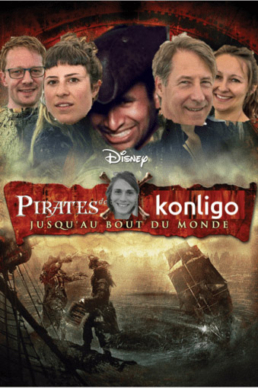What is it like to work at Konligo ?
What is it like to work at Konligo? Record from Capucine, Communication and Sustainability Intern
When I first arrived at Konligo, I didn’t know what to expect. For my future career, I have always wanted to work in an NGO, and this was my first internship. I didn’t know anything about the start-up world and was very curious to discover it.
I rapidly found out that since a start-up is basically a project coming to birth, it also means an exciting new adventure. And a new adventure means enthusiastic people, creative minds and most of all, loooads of ideas. In a start-up, there is always room for initiatives and new thoughts are more than welcome. You can just be your true self and give the craziest ideas you can have (not guaranteed they’ll be accepted but hey, if you don’t try, you’ll never know, right?) And if you fail, you can always retry and learn from your mistakes in order to succeed better later. Taking risks is part of the game!
Be yourself, accept the challenges and confront yourself to get out of your comfort zone. Working in a start-up like Konligo is also about working with people full of energy and dynamism, it is taking risks but not being afraid of it. Just like skydiving! If you don’t want to jump out of the plane, you’ll never experience this very unique excitement and this amazing feeling of watching our dear Earth from above (and the terrible feeling of having your cheeks detached from your face, looking like Shrek’s donkey). Even though a start-up means that you don’t know how the next day will look like, it is good to keep moving, to bring changes and new opportunities. It is based on uncertainty regarding the projects, the team members, the financial situation or how you will be able to address the clients’ needs... You really have to involve a lot of your time and energy in the project but hard work always leads to results, either positive or negative, but at least you can learn from them.
A start-up like Konligo is the place where you bring everyone’s skills together, to create relationships and great team working moments. It is about gathering around a common project, doing several (and sometimes super different) tasks, with different (but always creative) people! In Konligo, it is about communicating, pitching your project, getting feedback, working on, logistics, sales but also writing articles or sourcing prospects, in French, in English, in Dutch… Start-ups don’t know boundaries! Working at Konligo made me discover new sectors, new functions and new people from different cultures, backgrounds and working areas.
For me, a start-up is like a baby to raise and to take care of. The “pregnancy time” is super exciting because it is all about planning how will it go, taking care of everything and being ready for the moment to give birth. And then when raising the “kid”, every development step is extremely important! Since everything there are so many things to do, being involved in such a process is a perfect occasion to teach, but also to learn a lot, from everyone, everything and every kind of situation. It is also the opportunity for “the family members” involved to discover new skills, to confront themselves during hard situations, having ups and downs but this is also part of life! Even struggling times can be appreciated because it is a challenge to overcome and once it’s done, it makes the efforts even more valuable.
So working for like Konligo is to me a unique experience that brings lots of responsibilities, risks to take, opportunities and opens some doors to new people, new discoveries and new adventures!
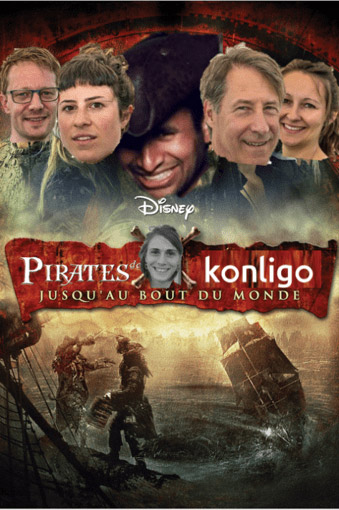
How to make events more sustainable?
Every year, trade and consumer shows generate 600.000 tons of waste. That represents 1 billion pounds and makes this sector the second-worst waste producer after construction.
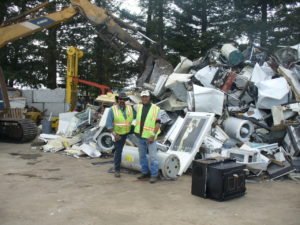
Most of this waste comes from all the flyers, posters, plastic bags, catalogs or cheap samples that are offered to visitors. In addition, there is the plastic that protects the carpets during assembly and the carpet itself during dismantling, which in most cases will never be reused. The stand carpet is usually packed in bulk, and the carpet located in the communal spaces is recycled. As the size of the trade show increases -and the proportion of stands with customized design (or non-reusable stands) with it the quantity of hazardous and wood waste can raise tremendously.
Of course, there are some simple solutions to this problem. Since nowadays we are living in a very technological/digital world, some tools could be really helpful in solving waste reduction in trade shows and fairs. Most people have a smartphone and a good way to avoid any waste (especially paper) is to develop an application or to use a QR code to collect the clients’ data for example, instead of losing time, energy and paper if done by hand. A digital catalog is a good alternative too, and is even more useful since the client can get access to any information and go through all the products on a tablet. The exhibitors can also provide reusable bags and biodegradable or even reusable beverage and food containers (plates and cups made out of cardboard or bamboo for example).
Why going paperless?
Going paperless is a good way to reduce waste and expenses: you avoid sending paper invites and printed advertisement memos by creating online event pages, apps and registering people via email, social networks and websites. Moreover, it gives quicker access to all of the internet information since it’s accessible at any time. An example is e-tickets as a very good alternative to all the printed tickets: the customers have them directly on their phones and have their badge linked to them. The advertising of an event is also a big source of waste, that can be avoided by communicating on social networks and websites and not by sending printed documents.

What about the food?
Trying to know how many people are surely attending the event enables to better anticipate food quantities and avoid food waste. The leftovers and food waste can also be given to associations. In addition, an event can also improve its carbon footprint by keeping things as local as possible when it comes to food or features for the event.
Concerning the plastic waste due to stands?
When it comes to plastic use, events’ stands waste a lot. First of all, they are, in most cases, used for a one-time purpose. This means that afterwards they are thrown away and not reused. Moreover, stand builders often paint them directly on-site, generating a lot of chemical waste too. Conventional paints are not sustainable and can lead to health problems since they contain some toxic ingredients, but natural paints are a better solution. Natural paints have recycled, natural or bio-based content. Then to wrap and protect all the stand elements (structure, panels, etc.) companies often use a huge amount of plastic which they throw away, instead of keeping it for later and reuse it.

And regarding the lights?
For the lightning, LED lights are way better and save energy but it is also possible to lower power efficiency to avoid energy waste. A white screen is a very good investment to project all the content digitally and to avoid all the panels and printed posters that are commonly used to show data and information.
Other tips?
An easy way for a venue to go greener is to make sure to recycle all the waste generated during the event, or to hire volunteers who could collect waste. In addition, all the waste such as the structures, stands and leftovers products should be donated to interested organizations and charities. Finally, a partnership with public transport should be developed and car-sharing should be encouraged. Some venues even have an International Sustainability Certification, such
as Manchester Central or ACC Liverpool, and choosing one of those options enables to boost the credibility of a sustainable event.
To conclude, there are many ways to reduce the carbon footprint when organizing events, and it only takes a very simple action to act for the best of our planet!
Sources:
https://helloendless.com/sustainable-event-trend/
https://www.eventbrite.co.uk/blog/plan-a-green-event-ds00/
https://aushimkoumar.com/2018/12/21/the-new-trend-in-exhibition-stands/
https://www.sciencedirect.com/science/article/pii/S0956053X09000075
https://www.tsnn.com/blog/why-going-green-matters-your-next-tradeshow
https://globalwarmingisreal.com/2012/11/26/5-industries-that-need-way-more-eco-attention/
https://smashhitdisplays.com/blog/trade-show-news/trade-show-industry-creating-most-of-the-worlds-waste
http://www.enviropaedia.com/topic/default.php?topic_id=183
https://www.tickpick.com/a-guide-to-planning-green-events
The new exhibition trend
The new exhibition trend.
Every year, ten-thousands of conferences and tradeshows take place around the world. Together, these 31,000 exhibitions attract more than 4.4 million companies who showcase their products and services to 260 million visitors.
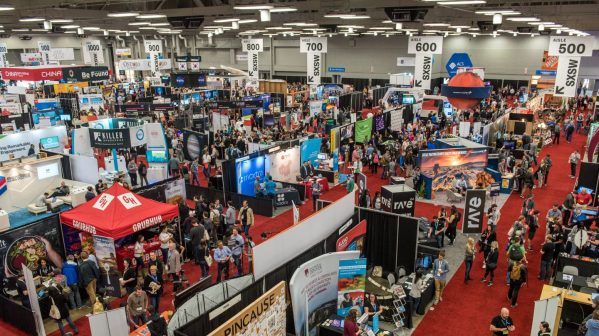
An overwhelming majority of these fairs (80%) are business-to-business events that last between two to three days. A typical business-to-business fair takes three to four days of preparation and one to two days to disassemble. In other words, the process of building up and taking down a business-to-business trade show is double that of the fair’s actual duration.
The budget spent on the infrastructure for these trade shows – mostly stands – is estimated at €60 billion, or an average of €2 million per fair.
Compared to trade shows, the world of business-to-consumer festivals and events is a thrifty one. Roughly 200,000 outdoor events are organised globally every year for a total budget of €20 billion. That means that €30,000 is spent on outdoor infrastructure per event.
What explains this dizzying, million-euro difference in budget? Organisers of outdoor festivals and events want to create memories and visibility for a company, and they are mostly business-to-consumer. For the tradeshow industry, the end game is to close business deals and that’s worth spending some money.
The illusion of permanence.
Every trade show exhibitor wants to stand out and impress prospective and current clients with a unique, eye-catching structure. At the same time, almost every exhibitor wants to create an atmosphere that feels anything but ephemeral. They want a stand that offers the illusion of permanence and gives visitors the impression that they’re standing in a real store.
But this emphasis on permanence doesn’t come cheap. Hundreds of people are needed to construct the trade show stands. To create a seemingly permanent display, the workers must plaster and paint over dozens of wooden panels and use coverings to hide the stands’ framework. This is the number-one reason that exhibition stands have such a lengthy installation time and steep cost.
This high price tag also means that stand builders are under pressure to keep labour costs as low as possible. Many of them for instance hire busloads of foreign workers, often from eastern European counties, and bring them to Belgium to construct and disassemble the stands. As soon as the job is done, these workers are shuttled back to their home countries.
Sustainable is the new black.
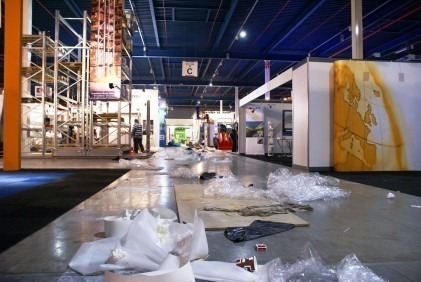
The mountain of waste that these 31,000 fairs generate, however, is perhaps what’s most disturbing. Because it’s easier to throw all the used materials away than to stock and re-use them. Tonnes of wooden panels, walls, furniture and decorative elements are discarded with every fair. Re-use is moreover not sexy because used materials don’t produce the new and permanent feeling exhibitors are looking for.
With their robust, modular aluminium stands, companies like Octanorm, BeMatrix and Aluvision are thankfully starting to put a dent in the amount of waste produced by tradeshows.
But when it comes to the large eye-catching structures seen at most tradeshows, there is still a long way to go. The emphasis on permanent-looking structures at temporary events remains the norm.
But why? Why hide a stand’s structural elements and cover it with panels, plaster and paint? Why give visitors the impression that the structure around them is a permanent one when a mere step outside the exhibition booth immediately shatters that illusion and brings them back to the here and now of the fair? Isn’t this a bit absurd?
We are moving in precisely the opposite direction in other areas of life. In digital marketing for instance consumers are thirsting for more authentic messages. Tired of scripted, slick advertisements, they want more spontaneous videos, without make-up and filters.
Something similar is happening in interior design. More and more, we are going back to incandescent light bulbs, to coloured electrical wires and to rougher designs in our homes. Things that once used to be hidden are now seen as integral elements of our decoration that deserve to be seen.
The world of exhibition stands is moving in a similar direction. Forward-thinking exhibitors today want rougher-looking temporary designs that are fully re-usable because sustainable authenticity is the new black. More and more, they are embracing authentic-looking stands and more genuine business-to-business exchanges.
Companies want to communicate what they stand for openly and transparently, and half-open stands with rougher designs go hand in glove with this trend. Instead of trying to disguise a structure’s temporary aspect, exhibitors are making it a central part of the design and refusing to hide its structural elements. What you see is what you get.
Under pressure
“1 on ten start-ups will be a success, 2 or 3 will survive more than 3 years and the remaining start-ups will fail”. Welcome in the start-up world.
So it began, more or less one year ago, my start-up journey. I was amazed by those stats I heard from the very beginning, but that excited me even more. Indeed, because all around us triumph is made more visible than failure, we overestimate our chance of success. And rightly so, the entrepreneur journey is already hard enough and – without optimism – almost impossible to bear.
The months that followed, I was caught in this start-up hype of people using Facebook, Uber, Tesla and Apple as examples of how we should manage our start-up. I was taught that we should set the bar high and have great expectations, but is this generated pressure really so healthy? Shouldn’t we adapt our speech for the 99% of the start-ups that will not become that great? Or for the 90% that will not be considered as a success? These 90% of start-ups that will not deliver the 10x return after 5 years, something that all venture capitalists are looking for.
To be honest, I’ve struggled with this, having a hardware start-up where scalability is a big issue. I knew that it would be very difficult for Konligo to realise that 10x return, but the pressure was high. Almost every person I met was urging me to define a business model where I could prove that I could realise this 10x return, that Konligo was the next “biggest tent producer worldwide”.
So I spent some months breaking my head and convincing myself that Konligo could do it, and that caused me more harm than good. Even though I have the greatest team members I could wish for, I began to feel demotivated and wasn’t looking at the real facts anymore, because I was “haunted” by this factor 10. “If we don’t meet that expectation Konligo will be a failure” I thought.
Until I let the pressure go. Until I realised that this wasn’t the reason why we started Konligo, why I was part of this adventure. I wasn’t part of this adventure because I wanted to sell the company in 5 years, cashing tons of money. Money has never been my motivation. I wasn’t part of this adventure to be in the Fortune 500, not at all. I was part of this adventure because I believed people would be impressed, fascinated and even finding it kind of magical to see our structures being deployed. You know the facial expression a child has when he discovers something fascinating? Well I wanted to see the same expression on adults’ faces when they see our structure. And this is still my motivation. So why would I care about the 10x return in 5 years?
At that moment I felt relieved, and I was able to think rationally again. We looked at the facts, and we found a business model that was in concordance with our team’s motivation and expertise. Our dedicated team and unique 15-years research expertise on the field gives us such a head-start compared to all our competitors that we don’t have to focus on this magical “barrier” of “5 years”. As a matter of fact, we only hear about the companies in the Fortune 500 when they are famous, and we tend to forget that most of them had a hard start.
Will Konligo not be considered a start-up success if we don’t reach the 10x return after 5 years? Well so be it. What is the definition of a start-up anyway? I prefer to define Konligo as a SME (Small-Medium Enterprise) with an amazing and motivated team that is discovering and loving the exciting adventure of entrepreneurship. And what I know for sure is that we will do everything we can to extend this adventure for quite some years! And that, dear reader, is my start-up world.
Privilege is invisible to those who have it
Making privilege
visible.
I recently witnessed a scene between a beggar and a well-suited man.
The beggar was asking the business guy money while he was withdrawing his cash. The latter started screaming at the beggar: “I’ve worked hard all my life to have the money I own now. And you, lazy bastard, what do you do besides asking people for money?!”. And he walked away towards his beautiful sport car, waving with his money to the beggar.
This scene shocked me: a true example of a lack of empathy and a lack of realising the privileges some of us have.
Understanding our privileges
Understanding our privileges is difficult because we are used to have them. This is typical behaviour of the human being: taking what one has for granted and only realising what one has once it’s gone. Privileges however are not easy to lose. We have them, or we don’t.
Privileges are therefore invisible to those who have them. But take some time to think about your privileges. Could you sum up some of them? Let me help you.
- Does one or both of your parents have a college degree?
- Have you always assumed you’ll go to college?
- Are you able to move through the world without fear of sexual assault?
- Did you ever have to skip a meal or were hungry because there was not enough money to buy food?
- Were you ever discouraged from an activity because of your race, class, ethnicity, gender, disability, or sexual orientation?
- Do you have more than fifty books in your household?
- Did your parents tell you that you can be anything you want to be?
And this is just a very small list of the privileges some of us have, and others don’t.
The link below shows a video derived from the exercise The Privilege Walk in which I recently participated. That exercise opened my eyes and made me realise that within the same university, there is a huge difference in privileges between students: https://www.youtube.com/watch?v=4K5fbQ1-zps
Stop judging, because not everyone has the same privileges as you
Privileges make a difference in determining someone’s future, in what a person will become, and how hard he will have to fight to reach his goal. However, as we tend to forget our privileges, we judge others by thinking that they had the same opportunities we had to be the person we are now. Nothing, however, is further from the truth. We are all different and that means that we cannot judge someone else if we don’t know what that person has been through or which privileges that person didn’t have.
So, let’s not judge the beggar, the cleaning lady, the waste collector, or whomever you may meet in your business or private live. What do you gain by judging them? What do you gain by feeling superior? I would say that we need to understand their stories before having an opinion about them. And if we don’t know them, then why bothering having an opinion about them? Let’s focus instead on things that really matter, like how to better yourself personally and professionally.
At Konligo , we try to breathe these core values every day, making working here a real pleasure.
Stop keeping score
The Go-Giver: A Little Story About A Powerful Business Idea – Bob Burg & John David Mann.
This very powerful quote is for me the foundation of every good relationship, personal and professional. I call it the “Art of Giving”: giving to others not because you must, not because you want something in return, but just because it’s your way of life.
As I told in a previous article, I was scared that I would have to put my values aside in the corporate world, but nothing could be less true. The book “The Go-Giver” was an eye-opener for me. Not only the content, but also the supporting community behind it showed me how many corporate people there are willing to give, just because it’s in their nature.
I decided to dedicate my tenth article to this very powerful book, and to highlight three of its most powerful messages.
Money shouldn’t be your focus, even if it’s your target
“You see? You can’t go in two directions at once. Trying to be successful with making money as our goal is like trying to travel a superhighway at seventy miles an hour with your eyes glued to the rear-view mirror.”
Even if every entrepreneur’s dream is to be successful – and for the majority this means making a lot of money with their business-, the book explains that this target cannot be reached when focussing only on the money part. You should keep a global view on your business and strive to reach success by focussing more on giving to others. It’s by working on your relationships, by building a community around you and by being true to yourself that you can reach your targets.
Be true to yourself, be authentic
“The most valuable thing you have to give people is yourself”
This is so true, and yet so scarce in our society. We lack authentic persons, persons that have values and norms and stick to them, regardless of the difficulty of the situation . Be authentic, and people will respect you for who you are.
To be authentic, however, you should first define your own values and norms. And in my opinion, being transparent and avoiding gossiping is one of the most important core values. A person’s authenticity and trustworthiness is for me deeply damaged when hearing him talking behind someone’s back.
Be open to receiving
“Every giving can happen only because it is also a receiving”
This is the most powerful advice I got from the book. The art of RECEIVING.
I always love to give, but when receiving, I feel embarrassed. For example, I do like to give compliments but if someone pays me a compliment, I deny it by replying“oh it’s nothing” or immediately trying to minimise what I did. This also count for my private life: I prefer to do something for someone, in the opposite case I feel guilty.
But this is a wrong mindset. And it hit me, thankfully, when reading the passage in the book when the main character (Joe) and his mentor Pindar were having a discussion. Not quoting this part would be denying you – in my opinion – the most important thought of the whole book.
It’s not better to give than to receive. It’s insane to try to give and not receive. Trying not to receive is not only foolish, it’s arrogant. When someone gives you a gift, what gives you the right to refuse it – to deny their right to give?
Receiving is the natural result of giving. If you give and then try to stop the receiving that comes back, you’re like King Canute watching the tide roll out and commanding it not to come back in. It has to come back in, just as your heart has to contract after relaxing.
I can’t deny it, I’m still struggling with this “law”. Really, It was a slap in my face, especially the sentence: “Trying not to receive is not only foolish, it’s arrogant”. I never looked at it that way and I’m incredible thankful to “Pindar” for teaching me this lesson which I try to apply every day.
The main take away message of this article is that “The Go-Giver: A Little Story About A Powerful Business Idea” is a must read book (and fortunately also a short one). It teaches you to appreciate the value of giving and staying true to yourself. And for those who are already familiar with the latter mentality, the book makes you realise that receiving is as important as giving: one can’t fully be perceived without the other.
Happiness is overrated. Really? I don’t think so
I heard that quote when discussing with friends about one of my favourite topics, happiness. It was a reaction to me saying that everyone on earth wants to be happy, a statement I truly believe.
This reply made me understand that happiness is an umbrella term and that people define it very differently.
My definition of happiness
Happiness is for me a state of mind, it cannot be correlated to the immediate feel good moments that you have when being tipsy, when buying a new car or when receiving money.
And that’s the main difficulty. We as humans are mainly focused on immediate satisfaction instead of on the long-term effect. Why? Because long-term benefits are almost impossible to measure. Buying a new car is something tangible, making it therefore easy to think that it could make you happy. Studies, like the 1978 study by the psychologist Philip Brickman, have shown, however, that tangibles things don’t have any influence on your long-term happiness level.
Of course you can have a big failure at work, you can lose something or someone very important, and that’ll make you angry, sad or you will feel hurt. But that’s a temporary feeling, at the end, your happiness level should not be affected.
Be positive
Reaching happiness is for everyone different. There’s no perfect recipe that one can follow to be happy.
In my case, the most important aspect is to have a positive mindset.
Happiness is a state of mind, therefore, if your mind is focused on the positive aspects of every situation you encounter, you will not be distracted by negative thoughts that could bring you down.
This is a difficult mental exercise. We tend to victimise easily, think negatively, blame others, because as a matter of fact, this is the most easy path for your brain.
But you need to build a new path in your brain, and make of this path a highway.
I’m practising “positive thinking” for more than 5 years now and the results are great. Like every exercise, the more you practice, the easier it becomes. You begin to see the world in a more positive way, you are more optimistic about your life and the world, you dare to deal with every difficult situations, etc.
One of the best result I had with being positive is that I now see every problem in my professional and personal life as a challenge to learn and to grow. So I don’t say “I’ve a problem”, I say “I’ve an exciting challenge”.
But that’s not all
Being positive is the first step but not the only one. I also feel the need to work on the following aspects in order to be truly happy, and being positive helps in maintaining these aspects alive and kicking.
- Love of family and friends. You need people that are close to you. People with whom you can be yourself, with whom you can share your funniest and saddest moments, your ambitions and your fears, your successes and your failures. Friends that “can look right through you and still enjoy the view” (quote derived from the book QBQ by John Miller).
- Fulfilment. At work and at home, you need fulfilment. Every person can define fulfilment in his own way, but you need to think about it and work towards? it. In my case, I define fulfilment by being able to work on challenging projects where I can constantly learn and help others. In other words, I define it by my current personal growth potential and the way I can inspire others.
- You need to feel safe, on health and financial issues. If you are strongly suffering on these issues, it will absorb all your energy. Of course, you will struggle with these aspects in your life, but it’s important to work on them with a positive mindset.
- Helping others. The feeling of helping others is one of the best feelings you can have. It doesn’t necessary mean that you need to give money to people in need, it can be helping the old ladies with the groceries, keeping the door of the tram open for someone who wants to catch it, sharing your knowledge with newbies, etc. When your focus is not on yourself but on others, you will reach a very high level of satisfaction (more in one of my future articles).
Is happiness overrated? Well it depends on how you define it. If you define it as a pursuit of “constant feel good moments with no life troubles at all”, then yes. Overrated, impossible and frustrating.
If it’s defined as a state of mind based on a positive attitude, then it’s feasible and satisfying. If fact, you can call it like you want, it doesn’t matter. What matters the most is the understanding that these exercises could improve your wellbeing and your life satisfaction, and therefore, the life of the people around you.
I feared the corporate world, but I was wrong
So, I feared that I wouldn’t find my place in the business world. I feared that I would have to put my values – which are based on helping others, empathy and happiness – aside to fit in this corporate world. But I was wrong…
The new adventure
Until last year, I combined working in the academic world (Vrije Universiteit Brussel) with volunteering for my own non-profit organisation (Edukado). Both of those worlds aren’t focused on profit:
- At the Vrije Universiteit Brussel knowledge is being shared with the world for free, as a way to help science.
- At Edukado we are helping locals of developing countries and Belgian students to build their own educational project and have a blast.
So, when I started with Transformactive, my biggest fear was that I wouldn’t be able to do what motivates me: inspiring and helping others.
The corporate world is changing
I realised, however, that the corporate world is changing, that it doesn’t only focus on profit anymore.
Whereas in the beginning, our ancestors’ main job was to hunt to survive, many of us now have the luxury to work without constantly feeling the survival pressure.
Like always, evolution is playing a role. The management model of most of the big corporates comes from a model derived from the industrial revolution. And after the different world wars, our countries had suffered a lot and a very stiff and hierarchical corporate management model was necessary to build wealth as fast as possible.
But this model is collapsing. With the fourth industrial revolution going on, we now have the luxury to think about wellbeing, happiness, fulfilment, grow, etc. The companies that don’t take that into account, suffer from a high turnover. And that changes everything.
A positive change
More and more companies are focussing on their employees’ well-being in order to decrease the high level of turnover that many of them are facing. Google is a perfect example, with a different corporate culture where they have staff working on keeping all employees happy to maintain productivity.
New companies are even rising without vertical management anymore. A lot of small companies or start-ups, but also a specific department of 400 staff members at Engie-Electrabel to name one, are opting for the “TEAL-model”.
This TEAL-model was introduced by Frederic Laloux in his book Reinventing Organizations. His model focuses on self-management and on bringing “all of who we are” at work, instead of just our “professional” self.
In my future articles, I will go more deeply into the TEAL-model and on the powerful idea of “giving to others” as one of the best way to have a healthy company.
The idea that I had about the corporate world is therefore old-fashioned. With the new types of companies that are rising everywhere, I’m very optimistic about the changes that will take place in our world, switching from the old stiff corporate culture to a much more agile structure, with the employees’ wellbeing as one of the main goals. Off course, it’ll be challenging to apply these changes to big companies with lot of employees, but I’m very curious as I’m convinced that this is the future. To be followed…
Why accepting criticism is your way to success
Norman Vincent Peale
I’m sure you know the feeling when someone criticises your work: your ego is hurt, you get defensive — or even aggressive — and try to prove by all means that you were right.
Most of the time, you are even angry at that person and conclude that he did not understand what you meant.
I will not deny that accepting criticism is difficult. It is, however, one of the best way to grow. Indeed, even if compliments and praises provide you feel-good sensations and boost your ego, they are not really instructive.
Criticism, on the other hand, if constructive and truthful, provides you with very accurate feedback on mistakes you made. As commonly known, you learn the most from your mistakes, and facing criticism is the best way to understand those mistakes.
It takes guts to give constructive criticism
You should realise that if your good friends or acquaintances criticise your work, it is for your own good, as they don’t win anything by risking upsetting you.
These honest people are willing to tell you the truth, allowing you to grow, instead of merely praising you so that you will like them in return. Such people are rare, so if you find them, keep them close, as they will be very important for your personal growth.
Be aware that you will also meet people that may want to harm you, so it’s important that you filter the constructive criticism — even if given in a disagreeable way — and just don’t pay too much attention to the rest.
How to handle criticisms in 6 steps
- In my case, I always start from the mindset that the one who is criticising me is doing it with the best intentions.
- That’s an important attitude that will allow you to listen to the criticism, which is the second step. In order words, don’t react! Don’t start to argue. Just listen.
- The third step is to avoid taking everything that is told personally. This is a very difficult step, as it requires that you look at your work from an external point of view. This will help you to understand that the criticism is in fact not aimed at you, but at your work. Remember: your past work is done, you cannot change it anymore. However, you can improve it for the future, and as a matter of consequence improve yourself. The only way to do that is by accepting the added value of the criticism to your work.
- Next, understand this added value by asking questions about the criticism. This will show your critic that you value her opinion, which is important for future collaboration. Furthermore, it helps you to dig deeper and uncover ways to improve even further.
- The fifth step is a very important one: express your gratitude. The person providing you feedback is spending his time on you. You can learn and grow thanks to her, so thank her and mean it. She will appreciate it and feel at ease to do it more often.
- Finally, learn from it. You don’t have to accept all criticism, everyone has his or her own opinion and it’s up to you to decide what are the take-aways. However, by applying the previous steps, you will be able to drop your ego low enough to be (almost) objective about the criticism on your work.
The next time someone criticises your work, apply these 6 steps and pay attention to your feelings. You will notice that you will feel better once you deal with criticism in a calm and objective way. This will help you to reach the stage where you will gladly ask to be criticised without beating around the bush. Believe me, you will grow faster than you can ever imagine!
Let’s make effective New Year’s resolutions
If you’re like most of the people, it hasn’t been the first time you defined New Year’s resolutions, and it hasn’t been the first time you failed to keep these resolutions. Why is that?
Why wait for New Year’s Eve?
Let’s have a look at one of the main “criticisms” I hear about the New Year’s resolutions: why do you wait for New Year to make resolutions? Why should New Year be a “redefinition” of yourself?
Off course you shouldn’t ONLY wait for New Year’s Eve to define goals to be a better person, but let’s face it, it’s a very special day.
New Year is starting, friends and family are all gathered to celebrate that special moment, so why can’t we use that magical moment as a motivation and inspirational source to be a better/healthier/happier person? Why is this a problem?
Aren’t you happy like you are now? Well yes, I am, but there are always things to improve. We, human, can always grow, that’s what makes it so beautiful, so interesting.
Don’t make it too general
Most of the New Year’s resolutions are too general. By defining a too general topic, you don’t explain and think about how you could achieve your resolution. Take the example of “I want to read more”. What does that mean? What is more? How do you plan to read more?
A better way therefore to define a New Year’s resolution would be to be specific and define short milestones that will provide you a quick feedback on how you are doing.
In my example, you could say: I want to read 20 books a year, starting with 1 book the first 4 months and from then on 2 books a month. You can go further and make a list of the first 5 books you want to read, and define how much “pages” you want to read per week.
By being very specific, you take the most crucial step people fail to do: you plan your resolution.
Be realistic and not too optimistic
Many of the resolutions are way too optimistic. So whatever you want, make sure it doesn’t ask too much effort from you, otherwise you will not be able to do it a year long.
If you love spending time on YouTube and hate reading, then don’t t make the resolution of reading more. Instead, think about why you want to read more: is it because you want to learn more about human psychology?
Your resolution could then be: “Viewing more instructive YouTube videos on human psychology”. The result would be the same, but you wouldn’t force yourself to do something you hate, and that’s a more realistic resolution.
Finally, if you plan your resolution, you can quickly estimate if your resolution is feasible and be less optimistic if it isn’t the case.
My take home message of this week: there’s nothing wrong to use the magical moment of New Year to define new resolutions. Make them, however, realistic and very specific, and try to already plan how you would realise them by defining short milestones (and treat yourself each time you reach your milestones! 😊).
